- How to Get Rid of Spurge Weed - December 24, 2021
- Guide to Craftsman LT2000 Parts: Where to Find Them Online? - July 15, 2021
- The Best Time to Spray Dandelions: Tips, Tricks and More - January 9, 2021
When most people think of lawn equipment, they think lawn mowers, and sure, that’s a lot of it. But there is so much more to lawn maintenance than just mowing. There’s gardening, planting, tilling, watering, weeding, and everything that comes along with owning and maintaining your own yard.
Finding the best lawn equipment can be a tad overwhelming, especially for the new homeowner, but that’s why we’re here. This in-depth guide with links to all of our reviews will help you find the best tools for the job!
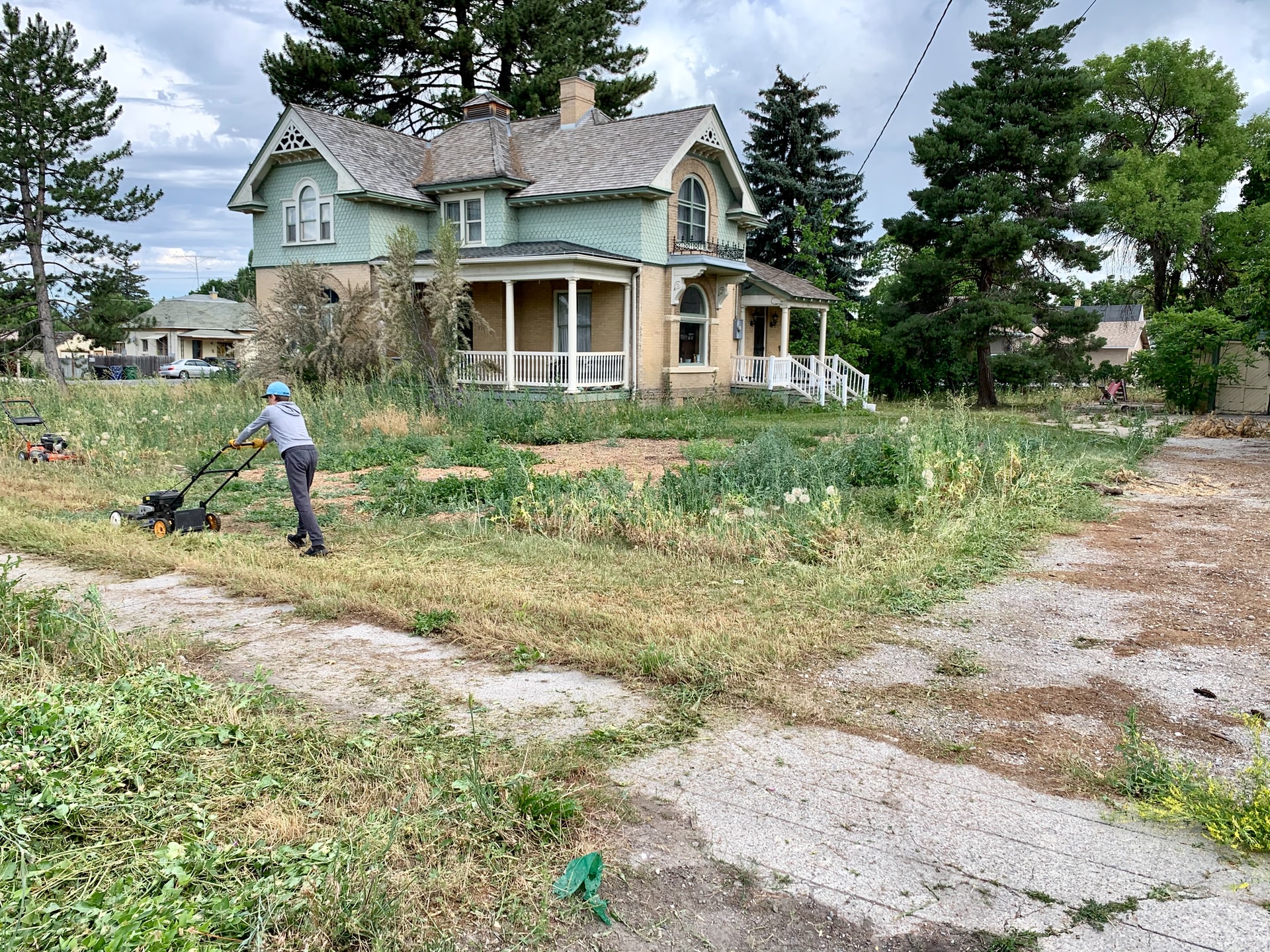
Mowing
Let’s start simple. Since your end goal is a beautifully maintained lawn that you can enjoy, we’ll start with mowers. The right mower for you will depend on the size of your lawn and how you intend to mow it.
There are two basic types of residential mowers: push mowers and riding mowers. Although there are plenty of other types, they’re typically larger and used mainly for commercial purposes.
Push mowers
Push mowers are great for small lawns or for people who enjoy getting their workouts mowing the grass. Even within the push mower category, there are several different types.
They come in different sizes, and you can get self-propelled push mowers that are a bit easier to move along, or you can get push mowers that require you to do all the work.
If you have a small lawn, a push mower is going to be plenty sufficient. They’re cheaper than riding mowers, require less maintenance, and are easier to operate. However, that doesn’t mean there’s a shortage of features.
You can raise and lower the decks to your desired grass height, some have push-button starts, and they come in a variety of colors. They also have bags that allow you to collect clippings, or you can leave the bags off if you’d rather spread the clippings out.
Getting a riding mower for a small yard is almost too much of a hassle than it’s worth. It’s a larger machine that will be difficult to maneuver through small spaces or around tight corners.
The only reason to make an investment like that is if you regularly mow a neighbor’s lawn as well, or if you truly do have trouble being that active for long periods of time.
Mowing a small lawn with a push mower doesn’t take very long at all. Snapper makes some of the best push mowers you can buy. Their range of pricing and features will fit in almost any budget and you can rely on the quality because they’ve been around for decades.
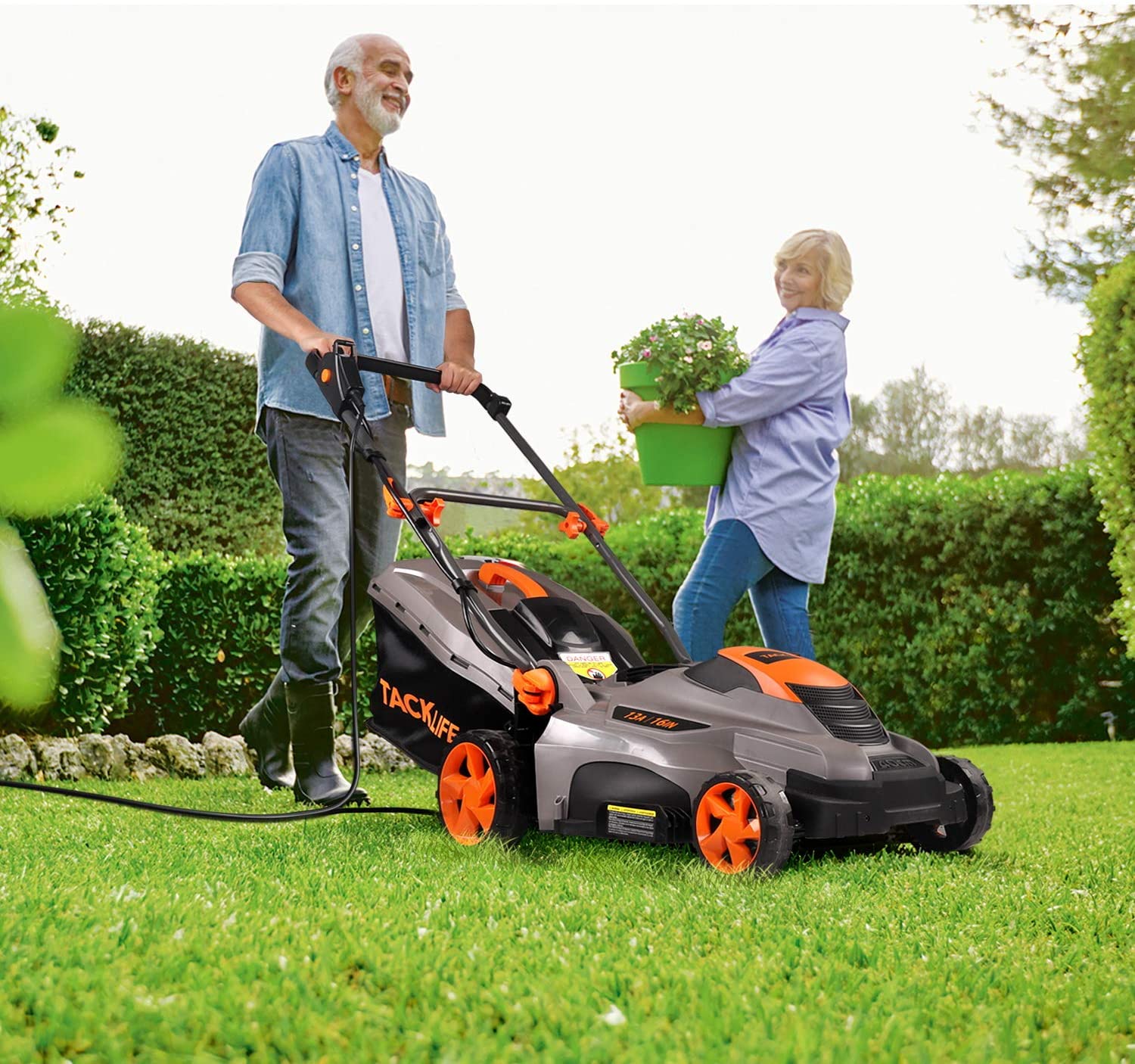
Riding mowers
Riding mowers are great for people who have larger lawns. If you mow an acre or more, a riding lawn is a good choice. They allow you to sit down and enjoy your time outside while getting the work done.
They still come in different sizes so they’re capable of handling different terrain and they’re excellent options if you have a sloped yard or something else that would be especially difficult to tackle with a push mower.
If you have wide-open spaces without a lot of obstacles, a riding mower can make rows up and down your lawn all day without any trouble, but it can also handle your garden edges, mowing around trees, and navigating other tricky spots.
You can still raise and lower your deck and bag (or not bag) your clippings, but these types of mowers also allow you to adjust your speed. If your yard is relatively flat, you can speed up and down in rows, knocking out your mowing relatively quickly.
The seats are comfortable, and they are typically equipped with some sort of failsafe so that if you happen to stand up or fall off of the mower, the engine will shut off. There’s not much that a riding mower can’t handle.
Craftsman and John Deere are two of the most reliable names in riding mowers. As you can probably imagine, the biggest names in tools and tractors can manufacture some great lawn equipment. They offer a wide range of sizes and styles, so you’ll be able to find exactly what you need.
With Craftsman, you’ll either get a Craftsman branded engine or a Briggs & Stratton engine. Either way, you go, you’re getting a quality machine.
Both manufacturers have been making this type of equipment for decades. However, Briggs & Stratton is one of the biggest names in small engines, so if you find yourself with a preference, look for a model number with this engine.
John Deere’s parts are all proprietary. They manufacture everything in-house, but for a name as big as theirs, you don’t need to worry about them knowing what they’re doing. They’ve been doing it for ages. And that signature John Deere green is what many people crave.
Large mowers
If you have an enormous yard, you may want to look into something a little larger. These fall outside of the realm of the mowers we’ve already looked at, but are viable options for people who have 5 or more acres to mow.
Zero-turn mowers and other commercial-grade mowers allow you to get your mowing done even more quickly. They are huge machines capable of tackling large swaths of land in very little time.
They’re easy to use, really fun to drive, and very durable. However, you’ll pay the price for one of these bad boys. They’re not cheap. It’s worth it, though, to save yourself hours (and I do mean hours) of mowing in the hot summer sun.
There’s still a lot of variation in the category. Some you sit on, some you stand on. Some you drive with a single or a dual joystick system (hello, Mario Kart), and some you drive with a set of levers. They turn on a dime, so be careful or you’ll give yourself whiplash.
These types of mowers can typically handle even the roughest terrain without breaking a sweat, and you definitely don’t have to worry about clearing sticks, gravel, or other debris out of the yard before getting started. They’ll take it all in stride. But then, of course, they’ll fling it all every which way, too.
For the best professional quality mowers, check out Cub Cadet. Their lever system is easier to drive than many other brands and they offer several different models from which you can choose.
They’re pricey, but worth it for a heavy-duty mower that can handle a lot of acreages, rolling terrain, and thick grass or weeds. They also come with excellent warranties.
Edge trimming
There will inevitably be areas that your mower simply can’t navigate. That’s normal. After you’re done mowing, you’ll want to tackle edges, weeds, and tight spots. That’s what edge trimmers and weed eaters are for.
These handheld devices come in several different varieties. You can choose gas-operated, battery-operated, or electric options with a cord. They each have their own advantages, but the point is to be able to quickly tackle the unsightly edges that your mower can’t get to.
Gas-operated trimmers
Edge trimmers that use gas usually take some sort of gas/oil mixture. You can buy it premixed or you can learn to mix it yourself. It can be a pain, but the benefit to one of these types of machines is that it is a lot more powerful than a battery-operated tool and you’re not chained to a wall outlet.
They’re typically heavy, because you have to account for the weight of the liquid in the machine, but they work really well. Some people don’t like the emissions they create, but it’s no more than what you’re giving off from your lawn mower.
You can get bigger gas-operated edge trimmers than you can battery-operated edge trimmers, but they are much louder. They usually have pull-cord starters, although some may have push button starts.
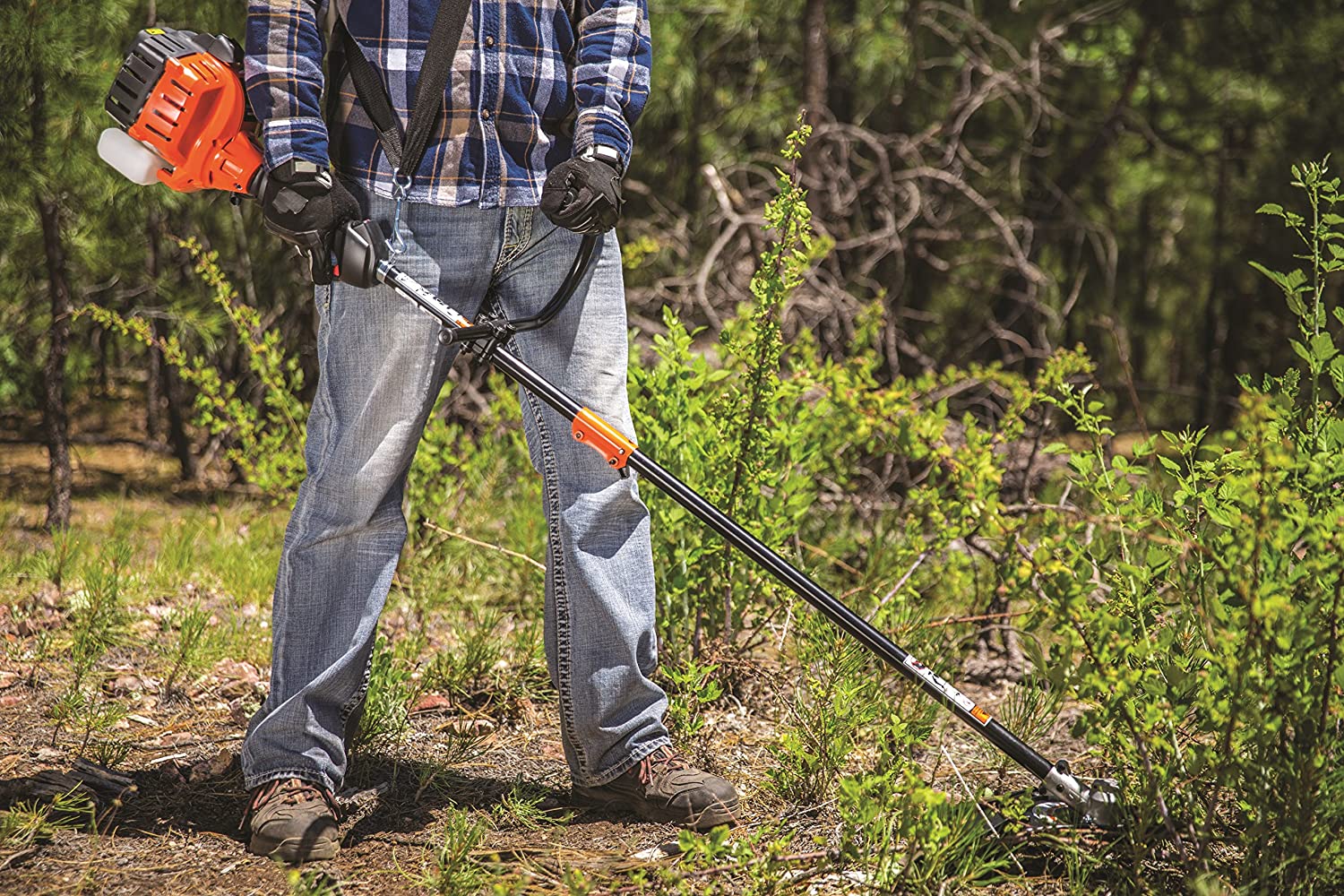
They’re ideal for large yards and thick grass because they can power through big jobs more quickly without running out of juice.
Within the gas-operated category, you still have some options. Two-cycle engines take a mixture of gas and oil, but they’re quite a bit cheaper. Four-cycle engines eliminate the need to mix gas and oil because they only take gas, but they’re more expensive. However, they’re quieter, easier to start, and produce less emissions.
One feature you can be on the lookout for, although it’s not necessary, is a centrifugal clutch. This feature allows you to idle the trimmer, so it remains powered up, but your line won’t spin.
It’s a useful feature that offers both convenience and safety to those who will be doing a lot of stopping and starting while edge trimming.
There are a few more downsides to keep in mind. Gas-operated edge trimmers require a bit more regular maintenance than other varieties and they can be quite pricey. But you’re getting a lot of value out of a machine that will work really well.
Battery-operated trimmers
Battery-operated edge trimmers still give you an edge (see what I did there?) over cordless varieties because you’re not stuck to a wall outlet. You have the freedom to roam about the lawn, trimming back edges and chopping down tall weeds.
However, you do have to make sure your battery is fully charged before you go. Over time, your batteries could lose the ability to hold a charge, which means you may need to replace them.
In general, you’re not going to get as much power from these as you will a gas-operated edge trimmer, but it will be a lot quieter, much easier to start, and you won’t have any emissions.
They’re also a lot lighter, so if you don’t have much upper body strength, it’s definitely a better choice. You can get extra batteries to be sure you always have one on the charger, making it easier to make sure it’s always operational.
This is a smart choice to eliminate the need for recharging, which could take up to two hours. If you’re on a lawn maintenance kick, or you know there’s rain in the forecast, you may not have two hours to wait.
When it comes to battery-operated edge trimmers, you have a few quality options. DeWalt has the most variety, and they make a quality product. I’ve had my DeWalt for years, it works like it’s supposed to, and it’s sufficient for a residential yard.
However, Milwaukee, while not offering quite the breadth of options, has something that’s a few steps above in performance. For a battery-operated tool, you’ll be surprised at how much power it can put out. It can whack through thick brush and is a fantastic tool for larger yards, acreages, or farms.
Check out our list of best brush cutters for trimmers.
Other electric options
The final edge trimmer option you may want to choose is one with a cord. It offers the same no-emissions benefits as the battery-operated variety, but you’ll get the added benefits of being plugged into power all the time, which gives you a little extra oomph.
Of course, you already see the downside coming. You can only go so far as the cord will reach. You’ll need extension cords to reach the farthest parts of your lawn, the cord is constantly getting in the way, and you do run the risk of cutting through your cord with the edge trimmer itself.
It really is, in my opinion, the worst of the three options. However, people still use them and enjoy them. They’re affordable and they work well. There’s very little maintenance required, you don’t have to purchase extra batteries, and they typically live very long lives.
You also don’t have the same fuss and worry about a gas and oil mixture as you would with a gas-operated trimmer, but you can often experience almost the same level of power.
Tilling and cultivating
Tilling and cultivating are similar, but there are some critical differences. Cultivators are smaller tools meant for gardens while lawn tillers are larger tools meant for bare ground.
Check out the difference between tiling and harrowing.
Cultivating
Cultivators are great for loosening soil in your planting area. They can help you prep the area for pulling weeds or mix compost into the soil.
Cultivators can also aerate the soil and navigate tight areas between rows of plants in your existing garden. It’s a great all-season tool that many gardeners want because it makes things a lot quicker and easier.
Cultivators are better for small gardens because they’re smaller machines and they’re not meant for tough jobs. They’re great companions if you have a garden that needs regular attention.
They come with gas-powered engines or you can get electric models with cords or batteries. Gas-powered engines offer you more power than electric models, but they also have emissions, so if you’re not fond of that idea, you’ll want to consider an electric variety.
The best cultivators come from Earthwise. They offer a lot of options, so you’ll find the features you need at a reasonable price.
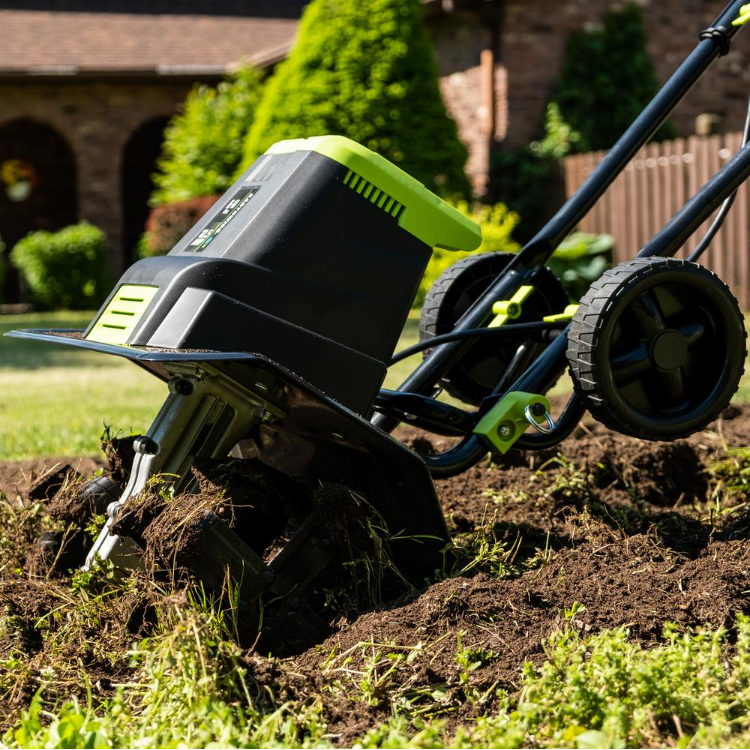
Tilling
Tillers are larger, have bigger blades, and can tackle tougher jobs on larger swaths of land. They’re meant to break up hard pieces of ground, so they’re great tools for leveling the ground in preparation for expanding your garden or planting a new garden.
This is the tool you need if you don’t have a garden yet or you want to expand your garden because it can break up the ground, even if you have incredibly rocky soil. It can be used as a residential or a commercial tool, but it’s also a bit more expensive than a cultivator.
Tillers also come with gas-powered engines or with cords or batteries, and the same principles apply. You’ll get more power from a gas-powered engine than you will a battery, but if you don’t like the emissions, you’ll want to consider other alternatives.
Some manufacturers will market their cultivators and tillers as interchangeable machines. While this isn’t always correct, sometimes it is. You’ll find that, for this reason, Mantis is one of the best options for tillers because of their variety. However, Craftsman is a solid choice, too.
Watering
There’s always the traditional watering can. It’s quaint and cute, and when your neighbors see you watering your window boxes, they’ll smile and wave. But it’s certainly not very efficient.
When it comes to watering your entire lawn, you’re going to need one of two things. It’s either a garden hose or a sprinkler system.
Both are equally viable options, but both have several different varieties to consider. Garden hoses are affordable. Even the most expensive garden hose won’t come close to costing what a sprinkler system would.
However, a sprinkler system comes with a lot of useful features and can add value to your entire home. It’s an investment that’s worthy of some thought if you can find it in your budget.
Garden hoses
Garden hoses are affordable tools. So affordable, in fact, that you could buy several of them. But did you know there are multiple types of garden hoses?
- Materials
For instance, garden hoses come in as many as 5 different materials. Vinyl is lightweight, affordable, and easy to handle. They’re not as durable as other types of hoses, but if they break, they’re cheap enough to fix.
Rubber is a lot more durable, but it’s heavier. It withstands drastic temperature changes a lot better than vinyl, so it will last a lot longer, and it’s less likely to kink or burst, which we all know is really annoying.
Plastic is more flexible than either vinyl or rubber. It’s lightweight, so it’s easy to move around and water different parts of your lawn. It’s easy to roll up and store when you’re done.

However, the coolest thing about garden hoses is that they come in collapsible materials that expand as they fill with water and then collapse as they drain. The hose lays flat for storage, so it takes up very little space, and it never kinks. These varieties are pretty pricey but so easy to use.
You can also get soaker hoses or sprinkler hoses that are made specifically for irrigation. You don’t have to attach a sprinkler to the end of it or move it around. You simply stretch it across the lawn and turn on the water.
They have holes throughout that allow water to either spray or seep through to the lawn. They don’t oscillate, so they may not cover as much ground as a sprinkler, but they’re pretty handy.
- Ply
Yes, garden hoses also come in different plies. The more layers a hose has, the stronger it will be. You should aim for 3-4, but most household garden hoses range anywhere from 1-6 ply. The more layers, the more expensive.
If you use your hose multiple times every day or it’s being subjected to severe temperature changes throughout the year, make sure you get something a little stronger.
- Other factors
Garden hoses also come in different sizes. You need to pay attention to nozzle diameter, hose length, and fitting material. All of these things come into play when shopping for a hose that will be useful to you.
A 10-foot hose isn’t going to do you any good if you need to reach the back of your yard that’s 20 feet away. However, there’s no sense in spending the money on a 100-foot hose and then struggling every day with the extra weight just to extend it 20 feet.
Good brands to look for when shopping hoses are Flexzilla, Craftsman, and Gilmour. Flexzilla makes some great kink-free hoses with their hybrid polymer material. The material is made to simply lay flat wherever you put it, even after it fills with water.
Craftsman has always manufactured plain old rubber hoses. They’re heavy-duty, all-weather hoses that can power your pressure washer and withstand many other commercial uses. In fact, you could probably run this hose over with your car and it would still last another 10 years.
Craftsman isn’t glamorous, and the rough black exterior can rub off on your hands, but it’s the perfect hose for you if you need something that will last.
Gilmour makes hoses that can be used as either a sprinkler hose or a soaker hose. They’re durable and versatile. It’s made from recycled plastic, which is pretty cool, so it’s a great hose that works for a lot of gardeners and it comes with a lifetime warranty.
Sprinkler systems
There are plenty of simple sprinkler systems on the market that you can install yourself, and often they don’t really require installation at all. But they can also get very complicated very quickly.
- Fixed or stationary sprinklers
These types of sprinklers vary in design as well as how far they can reach but they work in the same way. They connect to your garden hose and spray water in a pattern all over the same area of grass until you move it.
Fixed sprinklers can only cover 5-15 feet at a time, so they work best in small yards or gardens unless you want to be stuck moving them multiple times a day to cover a lot of area.
- Oscillating sprinklers
These sprinklers have a row of openings that spray water out in a semicircle. The sprinkler head then moves back and forth from side to side and the fan of water moves along with it. Your irrigation then covers a larger area than a stationary sprinkler.
- Rotating and impact sprinklers
This type of sprinkler spins 360 degrees as it releases water. Rotating sprinklers have two or more arms that spin while impact sprinklers only have a single jet that clicks as it turns. Impact sprinklers have a larger range of water distribution.
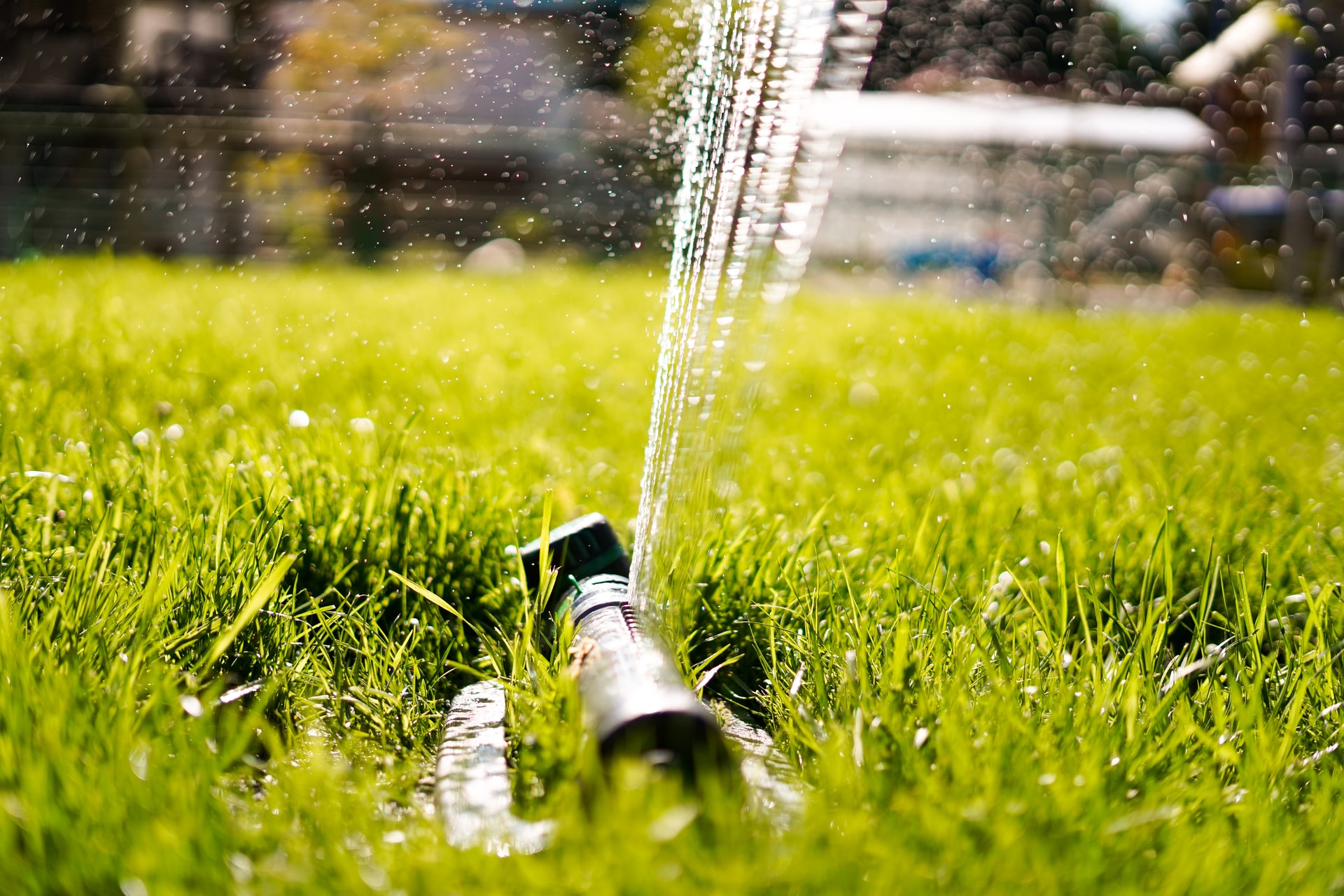
- Traveling sprinklers
These are actually pretty fun, especially if you have kids. All you do is program them in a pattern and they set out with a garden hose in tow, watering your grass along the way.
You can get them in different designs like tractors and trains, and they’re fun to watch driving all over the lawn, spraying water as they go.
Some are pretty simple and affordable. You don’t have to program them. They just drive along the path you’ve already laid out with your hose. You just lay down your hose throughout the lawn the way you want your sprinkler to travel, connect it to the vehicle, and turn it on.
- In-ground sprinkler systems
While in-ground sprinkler systems are by far the easiest, they also take a lot of time and money to install. You have to map it out, dig up your yard, and connect it to your main water line. You also have to make sure you place your sprinkler heads where they make sense to get the best coverage.
However, with the variety of in-ground systems on the market today, it’s worth it for some people. You can get smart systems that allow you to control your sprinklers from your smartphone and you can program them to come on at certain times.
They do range in price, so if you don’t have it in the budget to go all out on a fancy system with all the bells and whistles, you can still look into in-ground sprinkler systems. Some of the best in-ground sprinkler systems these days actually fall somewhere in the middle.
Rachio, Orbit, Rain Bird are all great options if you’re looking for connected sprinkler systems that offer either free consultations, DIY installations, or something else to make it a bit easier on the budget but still get you what you want.
Weeding
Many people weed their garden by hand, which is fine if you want to be on your hands and knees all afternoon struggling. However, if you’re serious about pulling weeds, there are some tools you may find useful.
There are two primary types of weeding tools. Short handled weeding tools may still have you down on the ground, but you’ll be able to pull those pesky weeds out by the roots. Long-handled tools can give you more leverage to get tough weeds out and lengthen your reach.
Short handled tools
These are really just smaller versions of long-handled tools. There is a wide range of styles, but the goal is to give you good control and a lot of power so weeding is as easy as possible.
- Hori Hori
Also known as the Japanese Farmer’s Knife, the Hori Hori is like a knife on steriods. One side of the blade is smooth for slicing and the other is serrated for stabbing and sawing. You can use this multi-purpose tool for opening bags of mulch or cutting through roots.
It can also be used for digging, cultivating, and prying weeds out of the ground. They’re usually made with carbon steel or stainless steel blade. Carbon steel has a sharper edge but rusts more quickly and will need more frequent sharpening.
I prefer this Nisaku model because it has inch markers directly on the blade. I’m able to ditch my tape measure and plant everything at the correct depth.
You may also opt for a Lesche digging knife, which is a bigger version of the Hori Hori. It has a heat-treated blade that’s a bit stronger. You can pry up rocks and pavers and it comes in both a right and left-handed version.
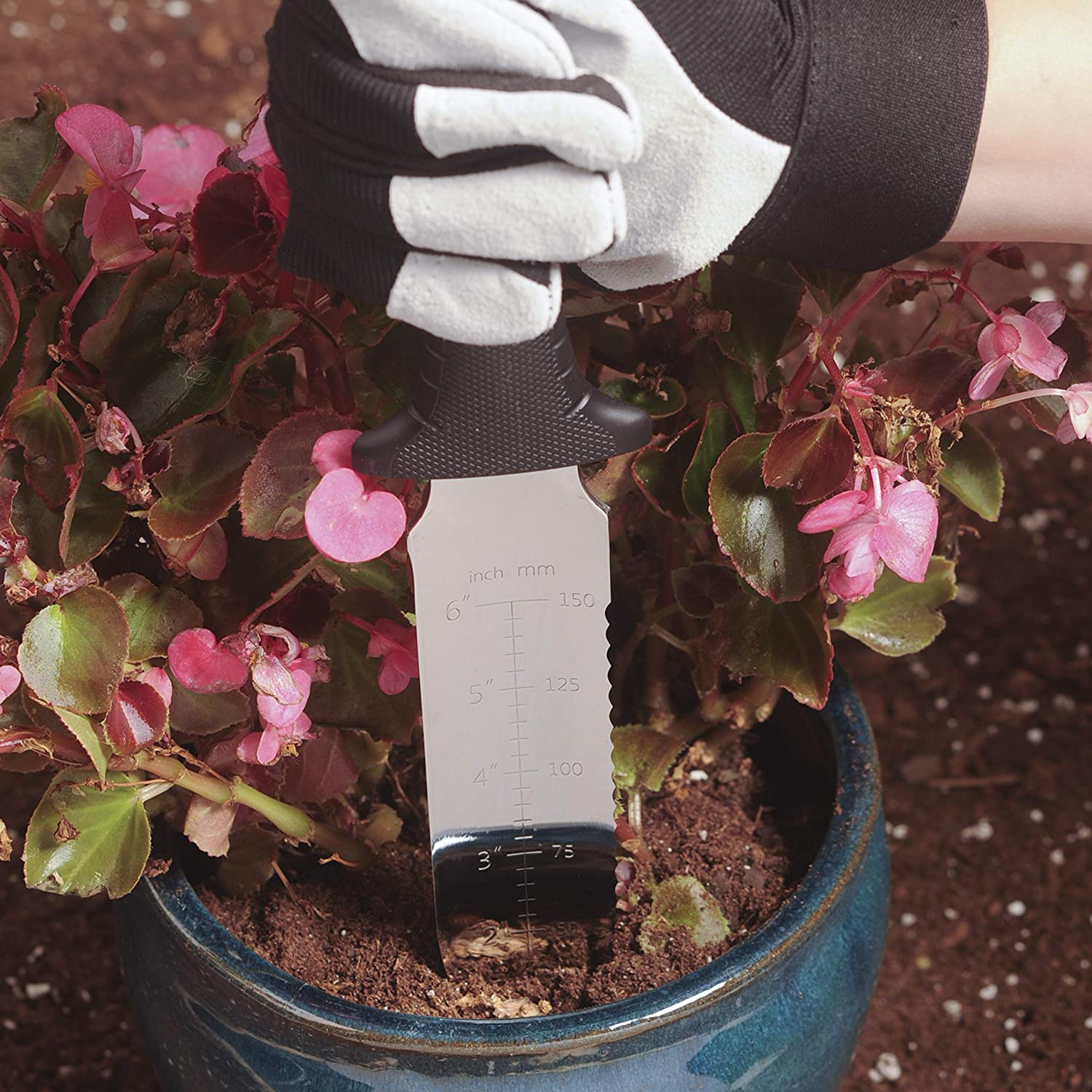
- Dandelion weeder
This is the tool that’s commonly used to dig up dandelions, but it has other uses, too. It has a V-shaped tip on the end of a long, narrow shaft. Shove it into the ground with the V facing the dandelion, pull back on the handle, and watch the dandelion come out.
It’ll even pop weeds out of hard ground, so it’s a must-have tool for all gardeners. They even make ergonomic versions with larger handles. Check out our full guide on how to get rid of Dandelions here.
- Cape Cod weeder
This one has an L-shaped blade that makes digging in tight spaces a lot easier. If you find weeds growing up in between your plants or flowers, you can use this to cut them off at the root. It’s easy to hold while reaching in between plants and it comes in a right and left-handed version as well.
- Hoe dag
Where this name came from, I don’t know, but it’s like a miniature pickaxe. It’s versatile enough to tackle planting, weeding, digging, cultivating, or removing clumps of grass. You can do a lot with this tool.
There’s a large and a small end of the blade used for different actions, and it’s easier on your wrist than other tools because the handle doesn’t require you to rotate as much. All you have to do is bury it in the ground and pull toward you. However, the motions aren’t as controlled.
- Cobrahead weeder
This one looks a bit scary, but you’re hoping your weeds think so, too. It has a curved blade that sinks into the soil naturally and can loosen soil or gouge roots.
It’s awesome for working in between plants or for pulling out large weeds by the root ball. You can also pull out large clumps of grass.
Long-handled tools
There are a lot of gimmicky items in this category that claim to make gardening a lot of fun or a lot easier. Some of these claims, you simply can’t trust, but the following tools are useful and I highly recommend having them.
- Dutch hoe
This is the type of hoe you’re probably familiar with. Simply rest the blad flat on the ground and slide the hoe back and forth as the blade slips under the soil to cut the weed from its roots.
You work from left to right and from the back of your flower bed to the front, dislodging weeds easily and standing upright the entire time. It saves your back and makes weeding easier on those who can’t bend over.
The Joseph Bentley Dutch hoe is one of the best quality, and it’s super affordable and easy to use.
You may also choose to use a stirrup hoe. It works in roughly the same way, except it’s shaped a little bit differently, it’s lighter weight, and it can cultivate your soil as you use it. Johnny Seeds makes some excellent stirrup hoes.
- Radius PRO weeder
If you have carpal tunnel, grip strength issues, or arthritis in your fingers, the circular handle on this tool is very useful. It has a long blade that slides into the ground when you step on the footrest.
It works well on dandelions and other taproot weeds. It’s a little heavy, but it comes with a lifetime guarantee.
Planting, seeding, and accessories
If you’re anything like me, your favorite time of year is when you get to plant and seed. I look forward to ordering my new bulbs, planning out where I’m going to put them, and then getting my hands dirty.
Maybe you’re aerating your lawn to fill it in and make it look more lush next year, or maybe you’re beefing up your landscaping to enhance your curb appeal. Either way, there are many useful tools for those of you who can’t wait to get your seeds in the ground.
Check out the main differences between Overseeder vs Slice Seeder.
While not technically pieces of equipment, these tools are very important to avid planters and gardeners, so make sure you have them on hand when it comes time to seed and plant:
- Shovel
- Trowel
- Spade
- Hand rake
- Garden rake
- Spreader
- Pruning shears
- Hedge trimmer
- Herb snips
- Plant ties
- Plant labels
- Plant auger
- Gardening gloves
- Knee pads or kneeler
- Apron or belt
FAQ
If you’re desperate to have a better-looking lawn, but you’re just not sure where to start, these frequently asked questions may help ease a bit of your pain.
Answer: Everything is subjective. When it comes to smaller equipment like edge trimmers and weed eaters, you’ll likely have really good luck with brands that manufacture hand tools like Black+Decker, Ryobi, Craftsman, Milwaukee, or DeWalt. None of them are bad, but you need to shop around for the features and prices you want before making a determination.
If you’re looking for bigger equipment, Mantis specializes in cultivators and tillers, and they offer an excellent range of options, while Earthwise has some really great battery operated varieties.
When purchasing lawn mowers, stick with brands like Craftsman, John Deere, Cub Cadet, or any name brand that uses a Briggs & Stratton engine, that way you know it’ll be good.
Answer: This largely depends on what work you’re going to be doing. If you have a small yard, you’ll want some small equipment. A push mower and a battery-operated edge trimmer will suit you just fine. You may want a few gardening tools here and there if you’ll be planting flowers, but you don’t need to go crazy.
On the other hand, if you have several acres, you’ll want a riding mower or a zero-turn mower, a gas-powered trimmer, a cultivator or a tiller, and plenty of tools for landscaping and weeding.
If your lawn falls somewhere in the middle, so will your equipment. There’s no one size fits all solution, but the beauty is that you can build your own solution and have fun doing it. What’s essential to you won’t be essential to your neighbor, but you can always share tools back and forth.
Answer: If you’re looking for a good deal, the same reasoning applies to lawn equipment as it does to everything else. You’ll want to buy it when it’s on sale, which is usually when purchase volume is low.
For lawn equipment, that’s when the season is over. Lawn mowers go on sale in August, September, or October, but you can sometimes get good deals in April and May. Be on the lookout for Memorial Day or Labor Day deals at hardware stores, because they’ll often discount lawn and gardening equipment during the fall and spring.
Final Thoughts
Lawn maintenance can be a bear, and it might seem like you need a lot of equipment, but with the right equipment on hand, it won’t take you nearly as long to get things done.
Evaluate your needs and your budget, do some research, and you’ll be well on your way to filling your garage with everything you need to make your lawn look beautiful.
Read more:

